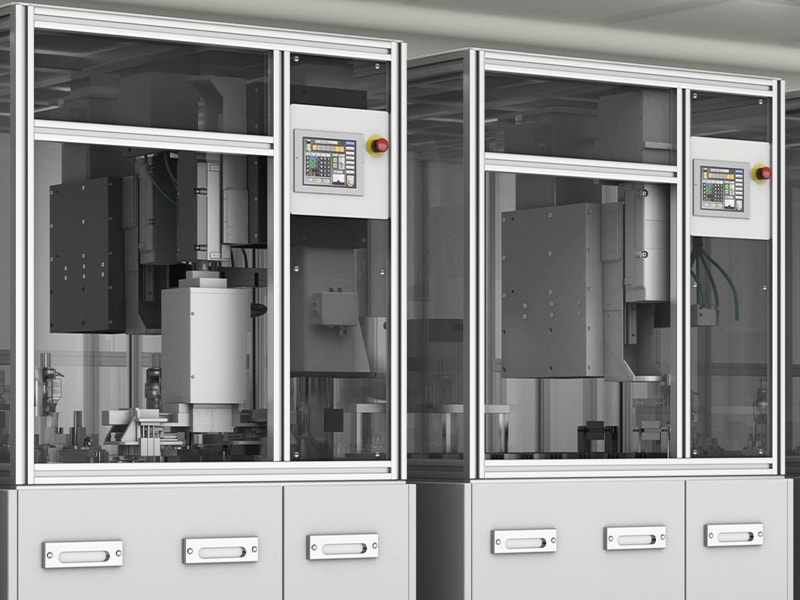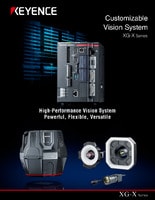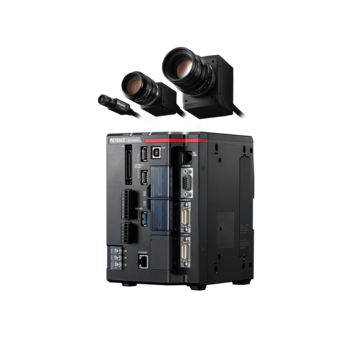Vision Systems
- Vision System with Built-in AI VS series
- Intuitive Vision System CV-X series
- Customizable Vision System XG-X series
- GigE camera and lighting for PC-based machine vision VJ series
- Inline 3D Inspection 3D Vision series
- 3D Vision-Guided Robotics 3D VGR series
- Line Scan Technology Line Scan series
- 2D Vision-Guided Robotics 2D VGR series
- LED Lighting CA-D series
- Lenses (for Machine Vision) CA-L series
- Machine Vision System Database VisionDatabase series
- Automotive
- Automation Equipment/Machine Building
- Electric Vehicles
- Medical Device Manufacturing
- Food/Beverage Packaging
- Semiconductor/Manufacturing Electronics
- Vision-Guided Robotics
- Solar
- Logistics
- Commodities
- Paper Manufacturing
- Machine Tools
- Electronic Device
- Printing
- Mining/Metals
- Fabric/Textile
- Tobacco
- Marine
- Aerospace
Vision Systems for the Automation Equipment and Machine-Building Industry

Vision systems have become crucial technologies in the automation equipment and machine-building industries since they offer a wide range of functions and features that significantly boost efficiency, precision, and reliability through advanced imaging techniques, machine learning, and AI algorithms.
The VS Series is an advanced vision system with AI capabilities for the automation equipment and machine-building industry. It offers sophisticated inspection and real-time decision-making capabilities, reducing human error and improving processes.
We’re here to provide you with more details.
Reach out today!

Applications for the Automation Equipment and Machine-Building Industry
Inspection of Automated Machinery Components
Vision systems for automation machinery are commonly used for their dimensional accuracy and tolerance checking. These systems ensure the assembly parts fit together precisely, e.g., automotive assemblies or aerospace components.
Quality Control in Machine Building
Machine builders and automation integrators commonly use vision systems to inspect parts for scratches, dents, corrosion, or other inconsistencies within the material with accuracy and precision. This also includes material verification through hyperspectral or multispectral imaging, assembly verifications (like presence and correct orientation), and several other quality control inspections.
Verification of Assembly Processes
Automated machinery and machine-building processes often require assembly and vision systems to check for the presence and correct orientation of each part during assembly, ensuring that all components are accounted for, properly oriented, and fitted. This extends to other assembly and fabrication methods, including weld inspections and geometric verifications.
Discover more about this product.
Click here to book your demo.

Introducing Our AI-Powered Vision System for the Automation Equipment and Machine-Building Industry
The automation and machine-building industry continues to evolve with innovations that enhance efficiency and productivity. Manufacturers are increasingly pursuing advanced solutions to optimize their production processes, which is why AI vision inspections in the automation equipment and machine-building industry are proving to be a game-changing technology.
Core features:
- High-Speed Processing: Quickly processes large volumes of visual data to optimize efficiency and minimize production downtime.
- Adaptive Learning: Continuously enhances accuracy by adapting to new data and identifying emerging patterns.
- Accurate Inspection: Detects defects and deviations promptly during the production process.
- Scalable Integration: Effortlessly integrates with existing manufacturing systems to enable seamless automation.
Our vision system boosts efficiency, enhances production quality, and sets a new standard for precision. Contact us today for more information!
Contact us to learn more about how our advanced technology can help take your business to the next level.
Contact Us
FAQs About Vision Systems in the Automation Equipment Manufacturing and Machine-Building Industry
What Are the Benefits of Using Vision Systems for the Automation Equipment and Machine-Building Industry?
Some of the biggest benefits associated with vision systems for automation equipment and machine building are:
- Enhanced quality assurance and quality control
- Increased production efficiency
- Reduced downtime
- Improved safety
- Cost savings through waste reduction
- Reduction of manual labor
What Types of Vision Systems Are Commonly Used in Automation Equipment and Machine-Building Inspections?
Some of the most common types of vision systems for automation equipment manufacturing include 2D vision systems comprising standard 2D cameras and line scanners and 3D vision systems comprising stereo vision, structured light, and laser triangulation systems. Other systems, such as IR imaging and hyperspectral and multispectral, are also used.
What Challenges Do Vision Systems Help Address in the Automation Equipment and Machine-Building Industry?
Vision systems for automation equipment and machine building address several challenges across the entire industry by eliminating labor-intensive and error-prone human quality control and inspection, as well as inaccurate placement of components, which might lead to assembly issues and downtime. Furthermore, they are great for manufacturing process optimization, as they’re great for identifying bottlenecks and inefficiencies in manufacturing and assembly.
How Do Vision Systems Support Traceability and Compliance Requirements in the Automation Equipment and Machine-Building Manufacturing Industry?
Traceability and compliance requirements are crucial factors in maintaining product quality, safety, and regulatory compliance, making vision systems an instrumental element in manufacturing and logistics. This includes serial number and barcode reading, data logging, component verification, and quality inspection.
What Are the Primary Considerations When Selecting Vision Systems for the Automation Equipment and Machine-Building Industry?
The primary consideration when choosing the right automated vision inspection equipment is mostly application-based. Consider application requirements first because understanding the specific tasks associated with your production will help you determine what kind of vision system your application might benefit from the most. The same applies to the type of vision system—referring to either 2D or 3D vision system, and its resolution, image quality, processing speed, and integrability with other systems and/or pre-existing setups.
We’re here to provide you with more details.
Reach out today!

Related Downloads
Related Products
Industries
- Automotive
- Automation Equipment/Machine Building
- Electric Vehicles
- Medical Device Manufacturing
- Food/Beverage Packaging
- Semiconductor/Manufacturing Electronics
- Vision-Guided Robotics
- Solar
- Logistics
- Commodities
- Paper Manufacturing
- Machine Tools
- Electronic Device
- Printing
- Mining/Metals
- Fabric/Textile
- Tobacco
- Marine
- Aerospace





